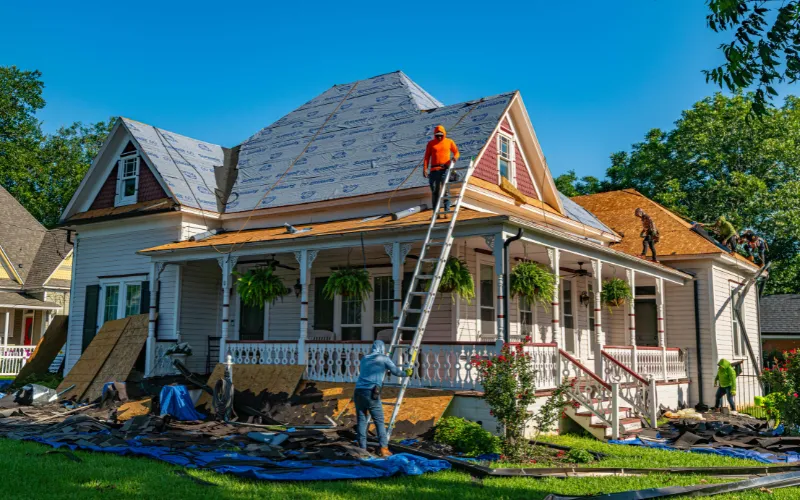
Pitched Roof Replacement: A Complete Homeowner’s Guide
Thinking about a pitched roof replacement? Good. You should. Because no roof lasts forever. Not yours. Not anyone’s.
A pitched roof is more than slanted wood and shingles. It shapes the whole house. Gives it character. Keeps you dry when it rains and safe when storms roll through. But here’s the catch. Even the best roofs wear down. Slowly at first. Then faster. Until one day, patching leaks isn’t enough anymore.
That’s when replacement comes in. Big job. Big cost. And yeah—it feels overwhelming. But avoiding it? Worse. Delay too long and water creeps in. Structure weakens. Repairs multiply. What started small turns ugly real quick.
This guide is for you—the homeowner staring at the roofline, asking “is it time yet?” We’ll go step by step. Signs your roof is done. Costs. Options. Materials. Hiring pros. No sales pitch. Just what you need to know before you commit.
Key Takeaways
A pitched roof replacement is protection, not just aesthetics.
Your choice of home roofing contractor matters more than brand names.
Cost depends on materials, labor, and hidden repairs.
Inspections twice a year can delay costly replacements.
A new roof can actually increase your home’s value.
The Basics of Pitched Roof Replacement
Roofs aren’t forever. Even the strongest ones.
What Is a Pitched Roof?
You’ve seen them. Sloping sides. A peak in the middle. Water runs off instead of pooling. Snow slides down instead of sitting heavy. It’s the classic roof style for a reason. Function meets design.
Why Replacement Matters
Old roofs fail quietly. A tiny crack today, a leak tomorrow. Before you know it—rot, mold, or worse, structural damage.
A pitched roof replacement wipes the slate clean. Think of it as starting over. A new shield. One that saves money in the long run.

Signs It’s Time for a Replacement
Homeowners often ask: “Repair or replace?” Here’s the truth. You can’t repair forever.
The Obvious Stuff
Shingles missing, curling, cracked.
Roofline sagging like it’s tired.
Moss eating it alive.
The Sneaky Stuff
Water stains on your ceiling.
Energy bills creeping up.
Leaks that “repairs” never seem to fix.
The Age Factor
Even if it looks fine, time wins. Asphalt beyond 25 years? Replacement time. Metal beyond 50? Same story. Don’t gamble.
The Real Cost of Pitched Roof Replacement
This is where most homeowners pause. Cost.
Materials Drive Price
Asphalt shingles: $4–$7 per sq. ft. Budget-friendly.
Metal: $8–$15 per sq. ft. Durable, eco-friendly.
Clay or slate: $15–$30 per sq. ft. Premium but heavy.
Labor Isn’t Cheap
Expect 40–60% of the bill to be labor. And honestly—that’s okay. A skilled home roofing contractor saves you from future disasters.
Don’t Forget the Extras
Tearing off the old roof.
Hauling away debris.
Fixing decking or flashing underneath.
Hidden costs? Always expect some. Better prepared than surprised.
Choosing the Right Residential Roofing Materials
Materials make or break your roof. And your wallet.
Asphalt Shingles
Affordable. Popular. Wide color options. But lifespan? 20–30 years max.
Metal Roofing
Tough. Fire-resistant. Energy-efficient. Lasts 40–70 years. Costs more upfront but pays off.
Clay & Slate
Luxury choice. Timeless look. Can outlast you. But heavy—might need reinforced framing.
The Step-by-Step Replacement Process
Most homeowners don’t know what actually happens. Here’s the breakdown.
Step 1. Inspection
Contractor checks your roof. Looks for damage. Evaluates structure.
Step 2. Estimate & Contract
You get a detailed quote. Scope, cost, timeline. Don’t sign vague ones.
Step 3. Tear-Off
Old materials removed. Messy, but necessary.
Step 4. Prep Work
Decking fixed. Underlayment installed. Flashing sealed.
Step 5. Installation
New materials go on. Shingles, metal, or tile carefully layered.
Step 6. Cleanup & Warranty
Site cleaned. Warranty explained. (Always ask for one!)

Finding the Right Home Roofing Contractor
This is where people go wrong. They chase the lowest bid. Mistake.
Qualities That Matter
Licensed. Insured.
Solid experience in residential roofing.
Detailed estimates.
References that actually check out.
Warning Signs
“Too good to be true” pricing.
Pushy sales tactics.
Contracts that feel vague.
A trustworthy contractor? Priceless.
Energy Efficiency & Value Boost
A new roof isn’t just protection. It’s savings.
Cool Roofing Options
Reflect heat. Lower A/C bills. Perfect for hot climates.
Ventilation & Insulation
Regulates attic temps. Cuts heating and cooling costs.
Resale Value
Studies show a pitched roof replacement recoups 60–70% of its cost. Buyers notice.
DIY vs Professional
Let’s be blunt. DIY roofing is risky.
The DIY Problems
Dangerous on steep slopes.
Mistakes lead to leaks.
Warranties voided.
Why Hire Pros
A home roofing contractor gets it right. The first time. Safer. Smarter. Long-lasting.
Mistakes to Avoid
Waiting until leaks destroy your attic.
Picking the cheapest contractor.
Ignoring ventilation.
Skipping underlayment.
Forgetting inspections after installation.
FAQs
1. How long does it take?
Usually 3–7 days, weather depending.
2. Can I stay home during it?
Yes. It’ll be noisy, but doable.
3. Is it covered by insurance?
Storm damage? Often yes. Wear and tear? Usually no.
4. Replace gutters at the same time?
If they’re old, yes. Saves money down the line.
5. How often should I inspect?
Twice a year. Spring and fall.
Conclusion
A pitched roof replacement isn’t just another home project. It’s peace of mind. It’s safety. It’s energy savings. From spotting early warning signs to hiring the right residential roofing contractor, every choice matters.
Call to Action
Don’t wait until leaks turn into disasters. Reach out today for a free inspection from a trusted home roofing contractor. Protect your home. Protect your investment.